Evaluating Corporate Governance Practices in Australian Charities
VerifiedAdded on 2023/03/21
|9
|1722
|52
Essay
AI Summary
This essay provides an analysis of corporate governance within Australian charities, comparing perspectives from governmental and non-governmental organizations. It examines the roles, responsibilities, and standards required for effective governance, highlighting similarities and differences between the ACNC's guidelines and broader views on both profit and non-profit entities. The essay emphasizes the importance of stakeholder management, conflict resolution, and the influence of organizational culture on governance practices, ultimately concluding that robust corporate governance is essential for the sustainability and success of Australian charities in fulfilling their missions and contributing to society.

BUSINESS COMMUNICATION SKILLS
Paraphrase This Document
Need a fresh take? Get an instant paraphrase of this document with our AI Paraphraser
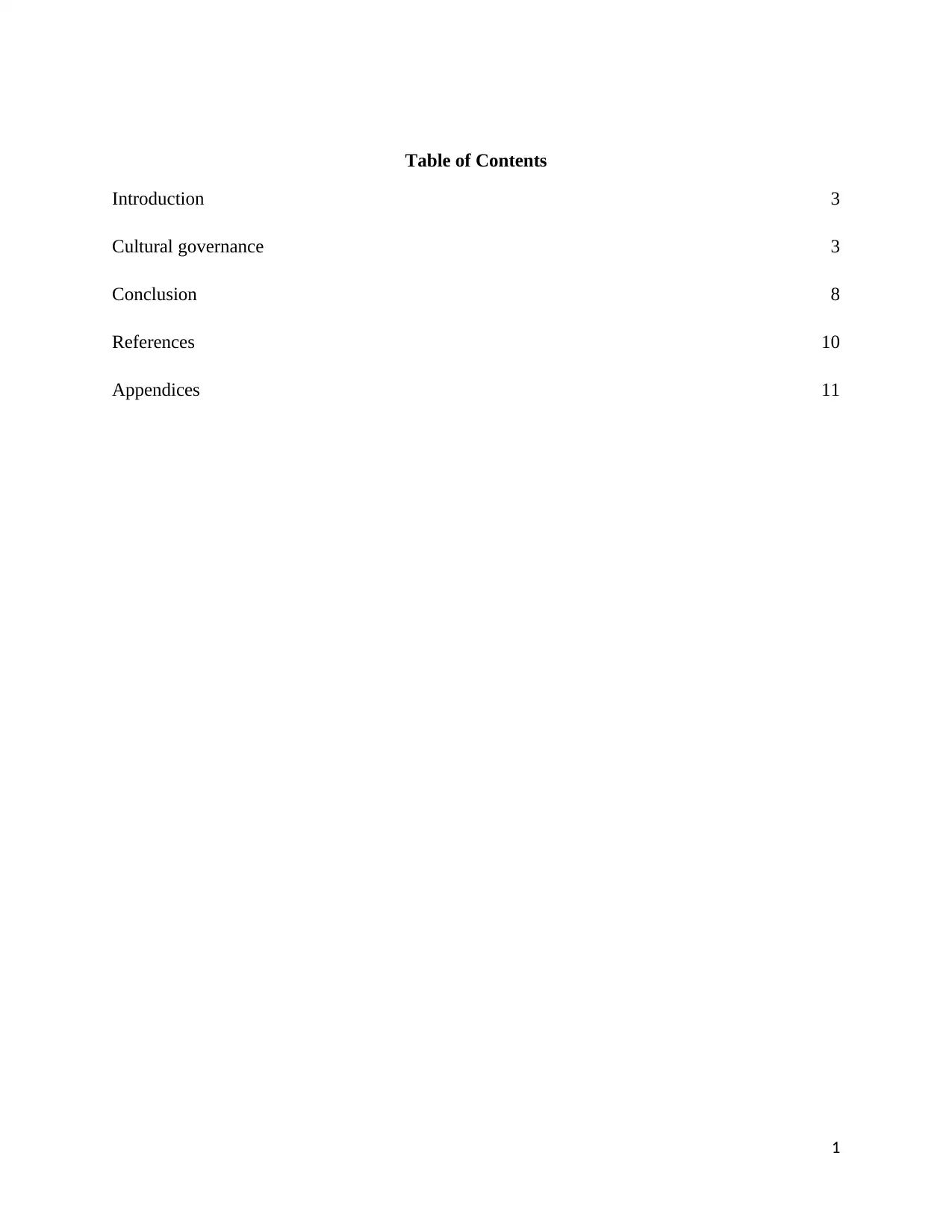
Table of Contents
Introduction 3
Cultural governance 3
Conclusion 8
References 10
Appendices 11
1
Introduction 3
Cultural governance 3
Conclusion 8
References 10
Appendices 11
1
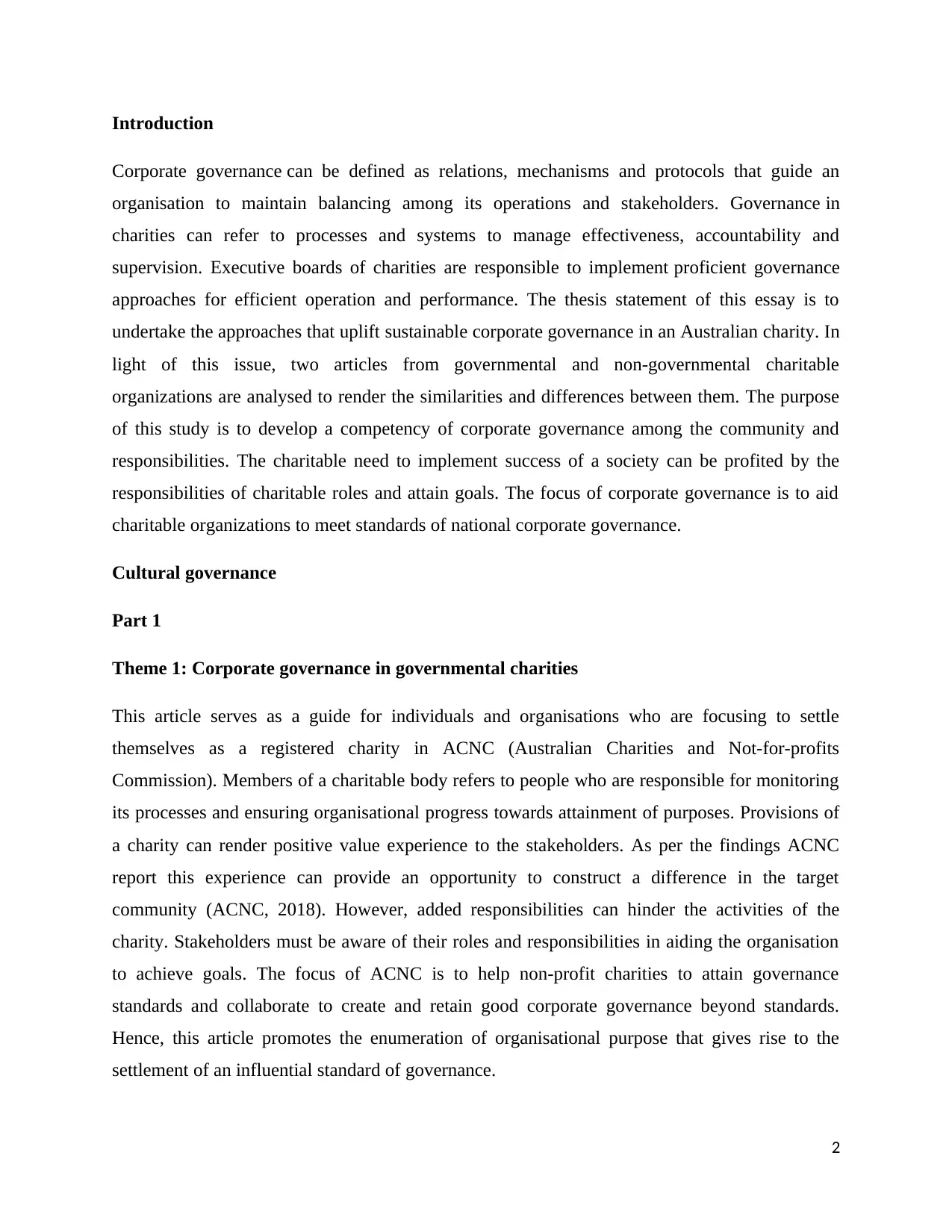
Introduction
Corporate governance can be defined as relations, mechanisms and protocols that guide an
organisation to maintain balancing among its operations and stakeholders. Governance in
charities can refer to processes and systems to manage effectiveness, accountability and
supervision. Executive boards of charities are responsible to implement proficient governance
approaches for efficient operation and performance. The thesis statement of this essay is to
undertake the approaches that uplift sustainable corporate governance in an Australian charity. In
light of this issue, two articles from governmental and non-governmental charitable
organizations are analysed to render the similarities and differences between them. The purpose
of this study is to develop a competency of corporate governance among the community and
responsibilities. The charitable need to implement success of a society can be profited by the
responsibilities of charitable roles and attain goals. The focus of corporate governance is to aid
charitable organizations to meet standards of national corporate governance.
Cultural governance
Part 1
Theme 1: Corporate governance in governmental charities
This article serves as a guide for individuals and organisations who are focusing to settle
themselves as a registered charity in ACNC (Australian Charities and Not‐for‐profits
Commission). Members of a charitable body refers to people who are responsible for monitoring
its processes and ensuring organisational progress towards attainment of purposes. Provisions of
a charity can render positive value experience to the stakeholders. As per the findings ACNC
report this experience can provide an opportunity to construct a difference in the target
community (ACNC, 2018). However, added responsibilities can hinder the activities of the
charity. Stakeholders must be aware of their roles and responsibilities in aiding the organisation
to achieve goals. The focus of ACNC is to help non-profit charities to attain governance
standards and collaborate to create and retain good corporate governance beyond standards.
Hence, this article promotes the enumeration of organisational purpose that gives rise to the
settlement of an influential standard of governance.
2
Corporate governance can be defined as relations, mechanisms and protocols that guide an
organisation to maintain balancing among its operations and stakeholders. Governance in
charities can refer to processes and systems to manage effectiveness, accountability and
supervision. Executive boards of charities are responsible to implement proficient governance
approaches for efficient operation and performance. The thesis statement of this essay is to
undertake the approaches that uplift sustainable corporate governance in an Australian charity. In
light of this issue, two articles from governmental and non-governmental charitable
organizations are analysed to render the similarities and differences between them. The purpose
of this study is to develop a competency of corporate governance among the community and
responsibilities. The charitable need to implement success of a society can be profited by the
responsibilities of charitable roles and attain goals. The focus of corporate governance is to aid
charitable organizations to meet standards of national corporate governance.
Cultural governance
Part 1
Theme 1: Corporate governance in governmental charities
This article serves as a guide for individuals and organisations who are focusing to settle
themselves as a registered charity in ACNC (Australian Charities and Not‐for‐profits
Commission). Members of a charitable body refers to people who are responsible for monitoring
its processes and ensuring organisational progress towards attainment of purposes. Provisions of
a charity can render positive value experience to the stakeholders. As per the findings ACNC
report this experience can provide an opportunity to construct a difference in the target
community (ACNC, 2018). However, added responsibilities can hinder the activities of the
charity. Stakeholders must be aware of their roles and responsibilities in aiding the organisation
to achieve goals. The focus of ACNC is to help non-profit charities to attain governance
standards and collaborate to create and retain good corporate governance beyond standards.
Hence, this article promotes the enumeration of organisational purpose that gives rise to the
settlement of an influential standard of governance.
2
⊘ This is a preview!⊘
Do you want full access?
Subscribe today to unlock all pages.

Trusted by 1+ million students worldwide
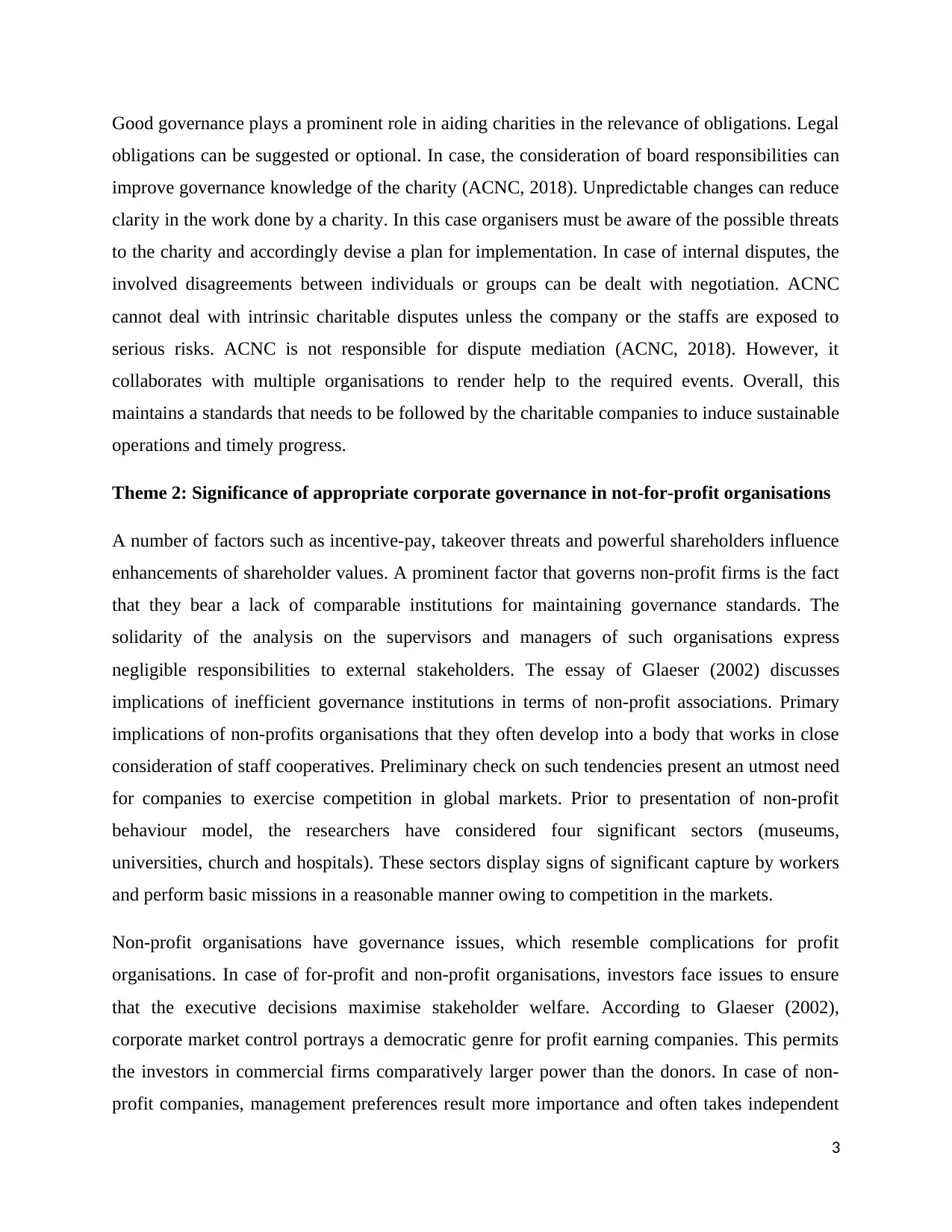
Good governance plays a prominent role in aiding charities in the relevance of obligations. Legal
obligations can be suggested or optional. In case, the consideration of board responsibilities can
improve governance knowledge of the charity (ACNC, 2018). Unpredictable changes can reduce
clarity in the work done by a charity. In this case organisers must be aware of the possible threats
to the charity and accordingly devise a plan for implementation. In case of internal disputes, the
involved disagreements between individuals or groups can be dealt with negotiation. ACNC
cannot deal with intrinsic charitable disputes unless the company or the staffs are exposed to
serious risks. ACNC is not responsible for dispute mediation (ACNC, 2018). However, it
collaborates with multiple organisations to render help to the required events. Overall, this
maintains a standards that needs to be followed by the charitable companies to induce sustainable
operations and timely progress.
Theme 2: Significance of appropriate corporate governance in not-for-profit organisations
A number of factors such as incentive-pay, takeover threats and powerful shareholders influence
enhancements of shareholder values. A prominent factor that governs non-profit firms is the fact
that they bear a lack of comparable institutions for maintaining governance standards. The
solidarity of the analysis on the supervisors and managers of such organisations express
negligible responsibilities to external stakeholders. The essay of Glaeser (2002) discusses
implications of inefficient governance institutions in terms of non-profit associations. Primary
implications of non-profits organisations that they often develop into a body that works in close
consideration of staff cooperatives. Preliminary check on such tendencies present an utmost need
for companies to exercise competition in global markets. Prior to presentation of non-profit
behaviour model, the researchers have considered four significant sectors (museums,
universities, church and hospitals). These sectors display signs of significant capture by workers
and perform basic missions in a reasonable manner owing to competition in the markets.
Non-profit organisations have governance issues, which resemble complications for profit
organisations. In case of for-profit and non-profit organisations, investors face issues to ensure
that the executive decisions maximise stakeholder welfare. According to Glaeser (2002),
corporate market control portrays a democratic genre for profit earning companies. This permits
the investors in commercial firms comparatively larger power than the donors. In case of non-
profit companies, management preferences result more importance and often takes independent
3
obligations can be suggested or optional. In case, the consideration of board responsibilities can
improve governance knowledge of the charity (ACNC, 2018). Unpredictable changes can reduce
clarity in the work done by a charity. In this case organisers must be aware of the possible threats
to the charity and accordingly devise a plan for implementation. In case of internal disputes, the
involved disagreements between individuals or groups can be dealt with negotiation. ACNC
cannot deal with intrinsic charitable disputes unless the company or the staffs are exposed to
serious risks. ACNC is not responsible for dispute mediation (ACNC, 2018). However, it
collaborates with multiple organisations to render help to the required events. Overall, this
maintains a standards that needs to be followed by the charitable companies to induce sustainable
operations and timely progress.
Theme 2: Significance of appropriate corporate governance in not-for-profit organisations
A number of factors such as incentive-pay, takeover threats and powerful shareholders influence
enhancements of shareholder values. A prominent factor that governs non-profit firms is the fact
that they bear a lack of comparable institutions for maintaining governance standards. The
solidarity of the analysis on the supervisors and managers of such organisations express
negligible responsibilities to external stakeholders. The essay of Glaeser (2002) discusses
implications of inefficient governance institutions in terms of non-profit associations. Primary
implications of non-profits organisations that they often develop into a body that works in close
consideration of staff cooperatives. Preliminary check on such tendencies present an utmost need
for companies to exercise competition in global markets. Prior to presentation of non-profit
behaviour model, the researchers have considered four significant sectors (museums,
universities, church and hospitals). These sectors display signs of significant capture by workers
and perform basic missions in a reasonable manner owing to competition in the markets.
Non-profit organisations have governance issues, which resemble complications for profit
organisations. In case of for-profit and non-profit organisations, investors face issues to ensure
that the executive decisions maximise stakeholder welfare. According to Glaeser (2002),
corporate market control portrays a democratic genre for profit earning companies. This permits
the investors in commercial firms comparatively larger power than the donors. In case of non-
profit companies, management preferences result more importance and often takes independent
3
Paraphrase This Document
Need a fresh take? Get an instant paraphrase of this document with our AI Paraphraser
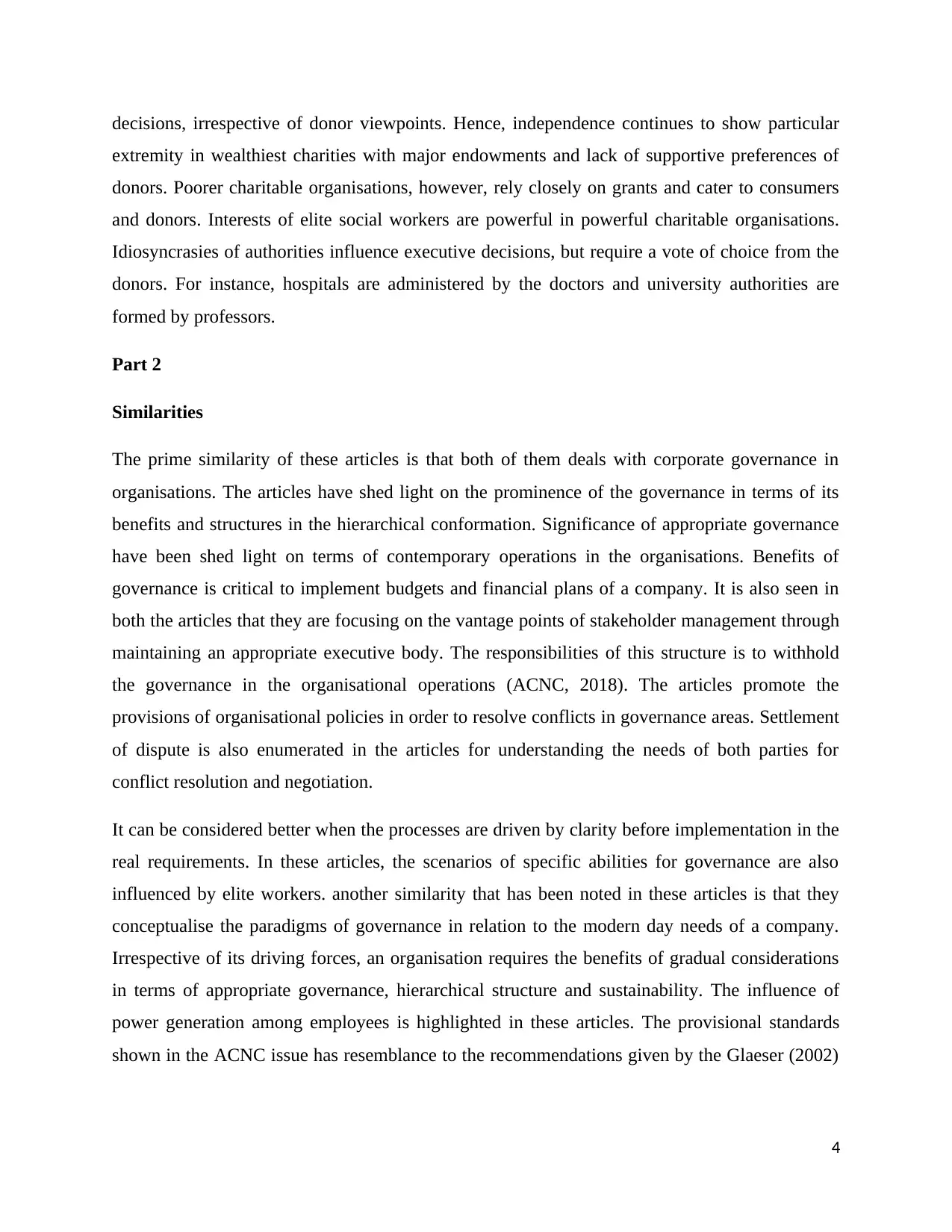
decisions, irrespective of donor viewpoints. Hence, independence continues to show particular
extremity in wealthiest charities with major endowments and lack of supportive preferences of
donors. Poorer charitable organisations, however, rely closely on grants and cater to consumers
and donors. Interests of elite social workers are powerful in powerful charitable organisations.
Idiosyncrasies of authorities influence executive decisions, but require a vote of choice from the
donors. For instance, hospitals are administered by the doctors and university authorities are
formed by professors.
Part 2
Similarities
The prime similarity of these articles is that both of them deals with corporate governance in
organisations. The articles have shed light on the prominence of the governance in terms of its
benefits and structures in the hierarchical conformation. Significance of appropriate governance
have been shed light on terms of contemporary operations in the organisations. Benefits of
governance is critical to implement budgets and financial plans of a company. It is also seen in
both the articles that they are focusing on the vantage points of stakeholder management through
maintaining an appropriate executive body. The responsibilities of this structure is to withhold
the governance in the organisational operations (ACNC, 2018). The articles promote the
provisions of organisational policies in order to resolve conflicts in governance areas. Settlement
of dispute is also enumerated in the articles for understanding the needs of both parties for
conflict resolution and negotiation.
It can be considered better when the processes are driven by clarity before implementation in the
real requirements. In these articles, the scenarios of specific abilities for governance are also
influenced by elite workers. another similarity that has been noted in these articles is that they
conceptualise the paradigms of governance in relation to the modern day needs of a company.
Irrespective of its driving forces, an organisation requires the benefits of gradual considerations
in terms of appropriate governance, hierarchical structure and sustainability. The influence of
power generation among employees is highlighted in these articles. The provisional standards
shown in the ACNC issue has resemblance to the recommendations given by the Glaeser (2002)
4
extremity in wealthiest charities with major endowments and lack of supportive preferences of
donors. Poorer charitable organisations, however, rely closely on grants and cater to consumers
and donors. Interests of elite social workers are powerful in powerful charitable organisations.
Idiosyncrasies of authorities influence executive decisions, but require a vote of choice from the
donors. For instance, hospitals are administered by the doctors and university authorities are
formed by professors.
Part 2
Similarities
The prime similarity of these articles is that both of them deals with corporate governance in
organisations. The articles have shed light on the prominence of the governance in terms of its
benefits and structures in the hierarchical conformation. Significance of appropriate governance
have been shed light on terms of contemporary operations in the organisations. Benefits of
governance is critical to implement budgets and financial plans of a company. It is also seen in
both the articles that they are focusing on the vantage points of stakeholder management through
maintaining an appropriate executive body. The responsibilities of this structure is to withhold
the governance in the organisational operations (ACNC, 2018). The articles promote the
provisions of organisational policies in order to resolve conflicts in governance areas. Settlement
of dispute is also enumerated in the articles for understanding the needs of both parties for
conflict resolution and negotiation.
It can be considered better when the processes are driven by clarity before implementation in the
real requirements. In these articles, the scenarios of specific abilities for governance are also
influenced by elite workers. another similarity that has been noted in these articles is that they
conceptualise the paradigms of governance in relation to the modern day needs of a company.
Irrespective of its driving forces, an organisation requires the benefits of gradual considerations
in terms of appropriate governance, hierarchical structure and sustainability. The influence of
power generation among employees is highlighted in these articles. The provisional standards
shown in the ACNC issue has resemblance to the recommendations given by the Glaeser (2002)
4
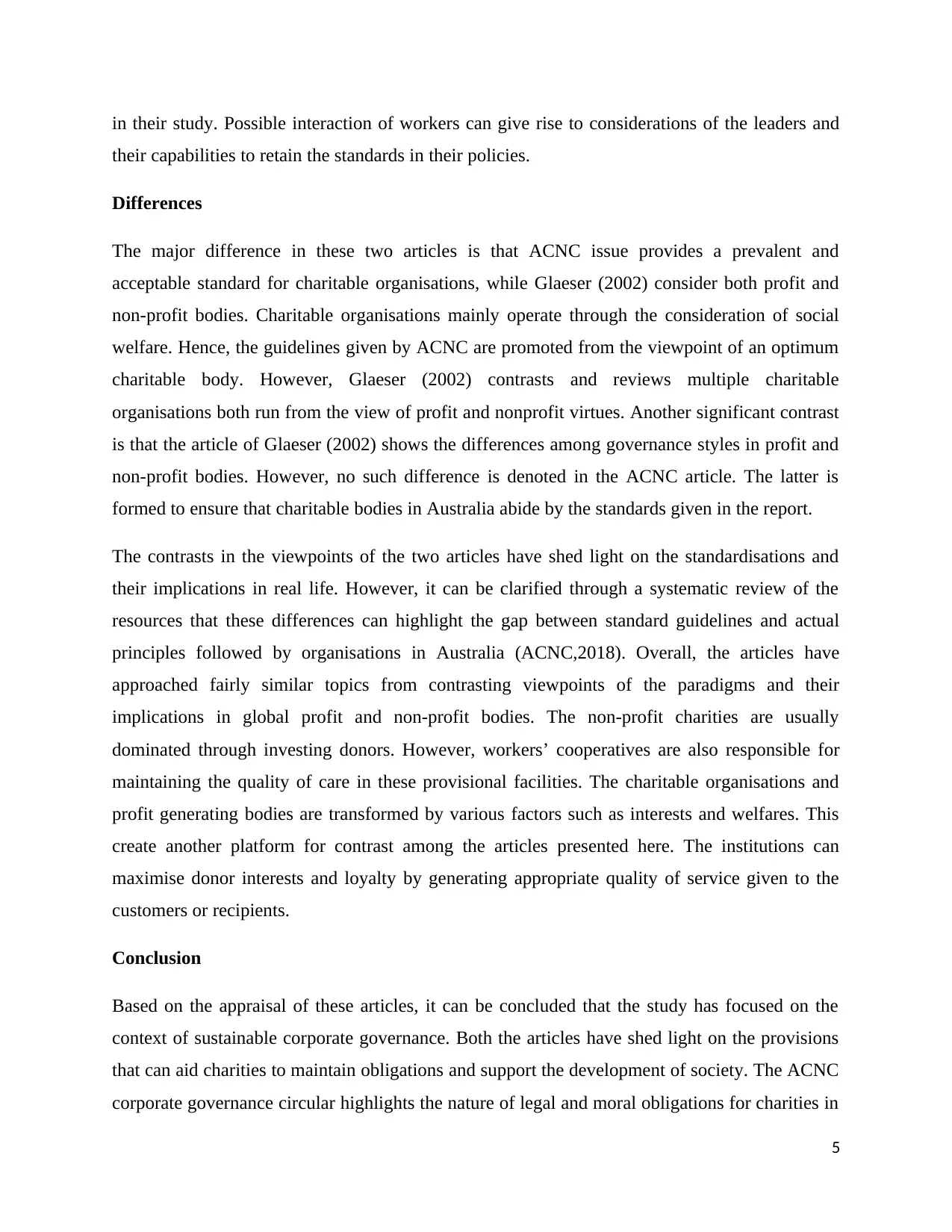
in their study. Possible interaction of workers can give rise to considerations of the leaders and
their capabilities to retain the standards in their policies.
Differences
The major difference in these two articles is that ACNC issue provides a prevalent and
acceptable standard for charitable organisations, while Glaeser (2002) consider both profit and
non-profit bodies. Charitable organisations mainly operate through the consideration of social
welfare. Hence, the guidelines given by ACNC are promoted from the viewpoint of an optimum
charitable body. However, Glaeser (2002) contrasts and reviews multiple charitable
organisations both run from the view of profit and nonprofit virtues. Another significant contrast
is that the article of Glaeser (2002) shows the differences among governance styles in profit and
non-profit bodies. However, no such difference is denoted in the ACNC article. The latter is
formed to ensure that charitable bodies in Australia abide by the standards given in the report.
The contrasts in the viewpoints of the two articles have shed light on the standardisations and
their implications in real life. However, it can be clarified through a systematic review of the
resources that these differences can highlight the gap between standard guidelines and actual
principles followed by organisations in Australia (ACNC,2018). Overall, the articles have
approached fairly similar topics from contrasting viewpoints of the paradigms and their
implications in global profit and non-profit bodies. The non-profit charities are usually
dominated through investing donors. However, workers’ cooperatives are also responsible for
maintaining the quality of care in these provisional facilities. The charitable organisations and
profit generating bodies are transformed by various factors such as interests and welfares. This
create another platform for contrast among the articles presented here. The institutions can
maximise donor interests and loyalty by generating appropriate quality of service given to the
customers or recipients.
Conclusion
Based on the appraisal of these articles, it can be concluded that the study has focused on the
context of sustainable corporate governance. Both the articles have shed light on the provisions
that can aid charities to maintain obligations and support the development of society. The ACNC
corporate governance circular highlights the nature of legal and moral obligations for charities in
5
their capabilities to retain the standards in their policies.
Differences
The major difference in these two articles is that ACNC issue provides a prevalent and
acceptable standard for charitable organisations, while Glaeser (2002) consider both profit and
non-profit bodies. Charitable organisations mainly operate through the consideration of social
welfare. Hence, the guidelines given by ACNC are promoted from the viewpoint of an optimum
charitable body. However, Glaeser (2002) contrasts and reviews multiple charitable
organisations both run from the view of profit and nonprofit virtues. Another significant contrast
is that the article of Glaeser (2002) shows the differences among governance styles in profit and
non-profit bodies. However, no such difference is denoted in the ACNC article. The latter is
formed to ensure that charitable bodies in Australia abide by the standards given in the report.
The contrasts in the viewpoints of the two articles have shed light on the standardisations and
their implications in real life. However, it can be clarified through a systematic review of the
resources that these differences can highlight the gap between standard guidelines and actual
principles followed by organisations in Australia (ACNC,2018). Overall, the articles have
approached fairly similar topics from contrasting viewpoints of the paradigms and their
implications in global profit and non-profit bodies. The non-profit charities are usually
dominated through investing donors. However, workers’ cooperatives are also responsible for
maintaining the quality of care in these provisional facilities. The charitable organisations and
profit generating bodies are transformed by various factors such as interests and welfares. This
create another platform for contrast among the articles presented here. The institutions can
maximise donor interests and loyalty by generating appropriate quality of service given to the
customers or recipients.
Conclusion
Based on the appraisal of these articles, it can be concluded that the study has focused on the
context of sustainable corporate governance. Both the articles have shed light on the provisions
that can aid charities to maintain obligations and support the development of society. The ACNC
corporate governance circular highlights the nature of legal and moral obligations for charities in
5
⊘ This is a preview!⊘
Do you want full access?
Subscribe today to unlock all pages.

Trusted by 1+ million students worldwide
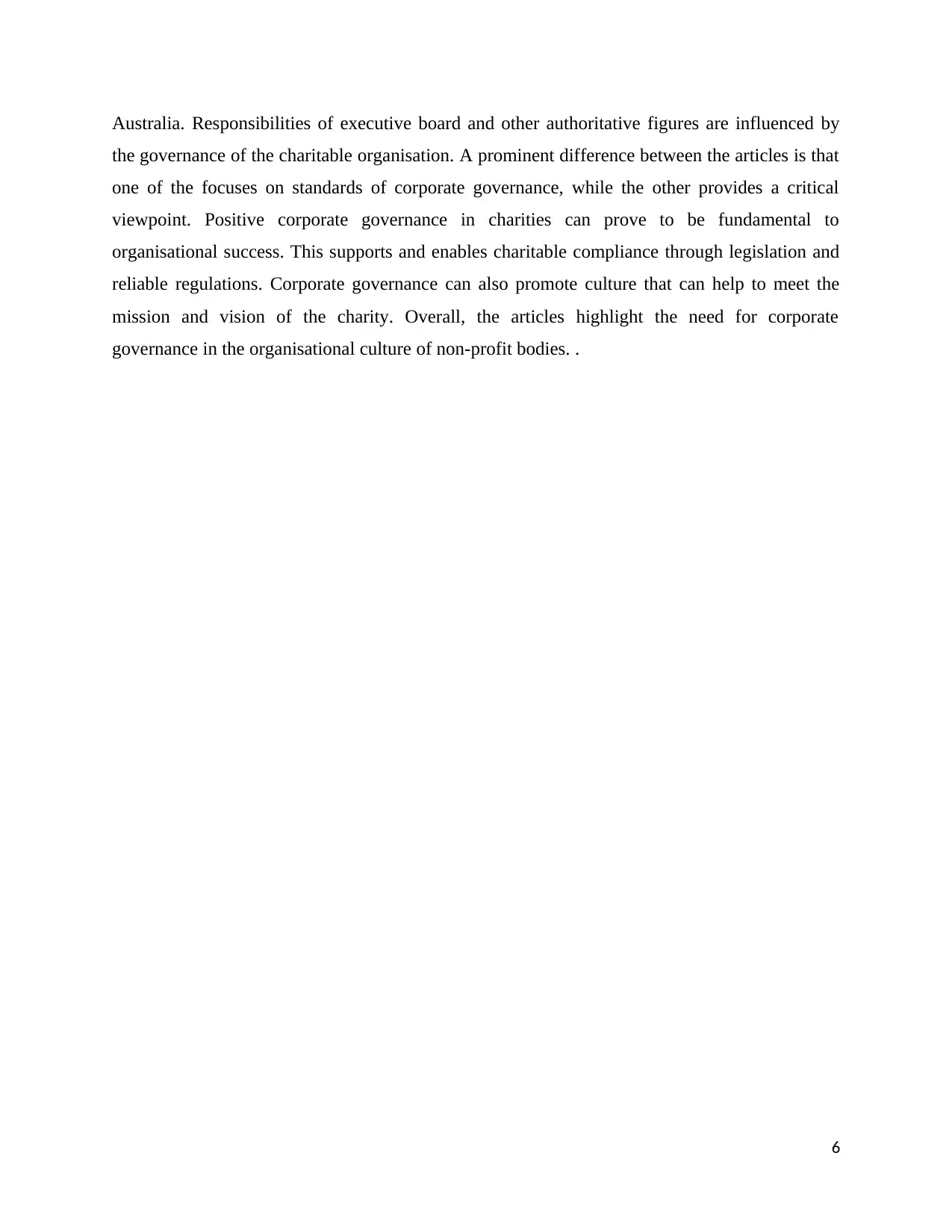
Australia. Responsibilities of executive board and other authoritative figures are influenced by
the governance of the charitable organisation. A prominent difference between the articles is that
one of the focuses on standards of corporate governance, while the other provides a critical
viewpoint. Positive corporate governance in charities can prove to be fundamental to
organisational success. This supports and enables charitable compliance through legislation and
reliable regulations. Corporate governance can also promote culture that can help to meet the
mission and vision of the charity. Overall, the articles highlight the need for corporate
governance in the organisational culture of non-profit bodies. .
6
the governance of the charitable organisation. A prominent difference between the articles is that
one of the focuses on standards of corporate governance, while the other provides a critical
viewpoint. Positive corporate governance in charities can prove to be fundamental to
organisational success. This supports and enables charitable compliance through legislation and
reliable regulations. Corporate governance can also promote culture that can help to meet the
mission and vision of the charity. Overall, the articles highlight the need for corporate
governance in the organisational culture of non-profit bodies. .
6
Paraphrase This Document
Need a fresh take? Get an instant paraphrase of this document with our AI Paraphraser

References
ACNC (2018) Governance for Good, Australian Government.
Glaeser, E. L. (2002). The governance of not-for-profit firms(No. w8921). National Bureau of
Economic Research.
7
ACNC (2018) Governance for Good, Australian Government.
Glaeser, E. L. (2002). The governance of not-for-profit firms(No. w8921). National Bureau of
Economic Research.
7

Appendices
8
8
⊘ This is a preview!⊘
Do you want full access?
Subscribe today to unlock all pages.

Trusted by 1+ million students worldwide
1 out of 9
Related Documents
Your All-in-One AI-Powered Toolkit for Academic Success.
+13062052269
info@desklib.com
Available 24*7 on WhatsApp / Email
![[object Object]](/_next/static/media/star-bottom.7253800d.svg)
Unlock your academic potential
Copyright © 2020–2025 A2Z Services. All Rights Reserved. Developed and managed by ZUCOL.





